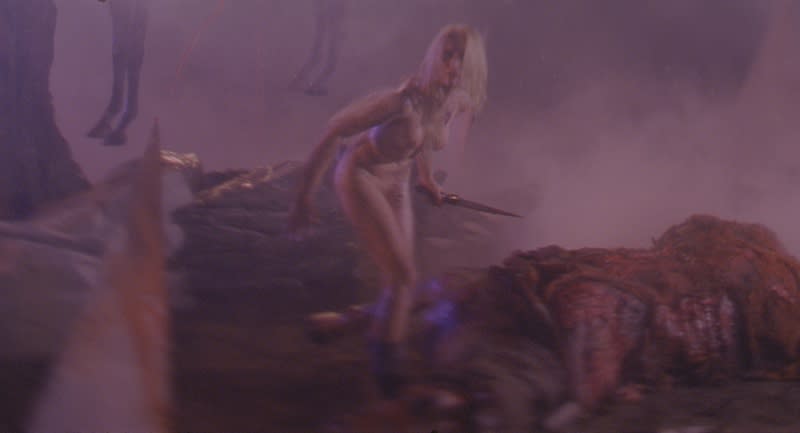‘After Blue’ Review: Erotic Lesbian Acid Trip Is Like ‘The Love Witch’ Set on Planet ‘Annihiliation’

- Oops!Something went wrong.Please try again later.
- Oops!Something went wrong.Please try again later.
- Oops!Something went wrong.Please try again later.
If you unearthed a glittery demon with one hairy arm who awakened your deepest desires from the third eye between her legs, what lengths would you travel to find her again? This, and plenty more completely insane scenarios, are among the many posed in Bertrand Mandico’s seductive, ethereal, and bizarre epic “After Blue,” aptly subtitled “Dirty Paradise.”
Set on a fantasy planet where only women can survive the harsh climate, the adventure follows a mother and daughter on a grueling journey to find and kill the evil “Kate Bush,” rumored to be death herself. One part “Annihilation” and one part “The Love Witch,” and cast under the veneer of a sadistic “The NeverEnding Story,” the film
More from IndieWire
The fantastical fable is narrated by Roxy (Paula-Luna Breitenfelder), a petulant teenager with a bleached-blonde mullet, who stares blankly into the camera in conversation with a mysterious disembodied voice. “The Earth was sick, rotten, so we had to look elsewhere,” she explains in the film’s opening. “We found After Blue in another system, a sort of paradise. We colonized, set new rules.” No screens, no electronics, and no wavelengths are allowed on After Blue, where only “ovarian bearers” can survive. Body hair is lethal on After Blue: The men all died when their hair started growing internally, and the remaining people trim their scraggly neck hairs with a blue laser knife.
Nicknamed “Toxic” by a trio of frolicking bullies, who exclude her from their giggling make-outs, Roxy finds a mewling head buried on the beach. “If you unearth me, I’ll grant your hidden desires,” she promises, and Roxy digs up the muddy head to reveal a shimmering temptress (Agata Buzek) with one hairy arm and long black nails . Pulled magnetically to this mysterious goddess, Roxy succumbs to a seduction that reveals a third eye between the woman’s legs. “My name is Kate. Kate Bush,” she says, before killing the three mocking girls and disappearing.
When Roxy’s village finds out she violated the laws of After Blue, which includes “eliminating the bad seeds before they take over,” she and her mother Zora (Elina Löwensohn) are swiftly exiled, only to return upon killing Kate Bush. Unsure of each other but their fates tied together, the two set off into the wild unknown, braving decaying forests and noxious mines. Lonely and stateless, Zora finds romance with an artist known as Sternberg (Vimala Pons), whose wealth cultural status have kept her above the fray.

Though “After Blue” is the rare experimental film with a cohesive narrative, it is still punctuated by abstract dream sequences and ethereal voiceovers. Roxy often hears Kate Bush’s voice surrounding her, and steals away every private moment to touch herself with the gun Kate Bush left behind. The detritus of consumerism remains in the names of technology, each gun has a brand name. A Paul Smith is a middling pistol, while a Gucci or a Chanel is much smoother shot. The android man Sternberg has made of her old lover is a Louis Vuitton.
“After Blue” is the cockeyed invention of queer French filmmaker Mandico, whose singular style first wowed in his debut feature “The Wild Boys,” which topped Cahiers du cinéma’s list of 2018 films. “The Wild Boys” also featured a cast of all women, including repeat appearances by Pons and Löwensohn. He is part of a new wave of queer French filmmakers, which includes his frequent collaborator Yann Gonzalez (“Knife + Heart”), who are breathing fresh life into genre, all with an added flare for the fantastical.
In his role as maestro, Mandico has assembled all the requisite elements and players to form a wholly original cinematic world. In addition to inspired casting (Pons and Löwensohn are particularly electric), that includes a hypnotic new wave score composed by Pierre Desprat; grotesquely visceral and otherworldly sets overseen by art director Thomas Salabert; rags-to-fashion costumes by Pauline Jacquard; and make-up artists Bénédicte Trouvé and Sarah Pariset.
Dripping with dirty eroticism, much like the goo that oozes out of many unknown holes, “After Blue” is as tactile as film can get. From live fuzzy worm cigarettes to a sensual romp in a psychedelic tree sap bathtub, every element of this wild ride has been carefully constructed to be bizarrely unique. A kaleidoscopic fantasy warped through the lens of a 1970s sci-fi Western, “After Blue” is a synthetic siren song for the freaks of the future and the past.
Grade: B
“After Blue” is currently streaming as part of this year’s Nightstream online festival.
Best of IndieWire
New Movies: Release Calendar for October 8, Plus Where to Watch the Latest Films
45 Directors Pick Favorite Horror Movies: Bong Joon Ho, Tarantino, del Toro and More
'Copshop' Breaks Through in Action-Crazy Specialty Box Office Rankings
Sign up for Indiewire's Newsletter. For the latest news, follow us on Facebook, Twitter, and Instagram.

